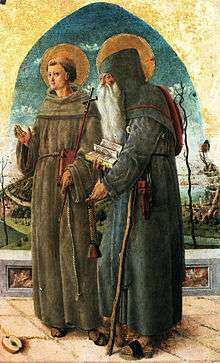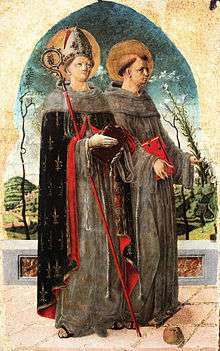Diocesan museum of Padua, Italy
| Established | 2000 |
|---|---|
| Location | Palazzo Vescovile - piazza del Duomo 12 |
| Type | Art, architecture, religion, Catholic |
| Website | http://www.museodiocesanopadova.it |
Coordinates: 45°24′25″N 11°52′20″E / 45.4069039°N 11.8722693°E The Diocesan museum of Padua was founded in 2000 in the bishop's residence which was constructed in the 15th century, but which has a foundation dating from the beginning of the 14th century. The building, close to the cathedral in the Piazza del Duomo, can be found in the historic center of the city which is the capital of the comune of Padua.
Works
Works of the museum come from the cathedral, dedicated to Mary's Assumption, and from other diocesan churches, and date from the 9th to the 19th centuries. These works can be found on two separate floors and are ordered chronologicallyl and by type.
The Hall of St. Gregory Barbarigo
On the first floor, chiefly for use by scholars due to the presence of the chapter library and the diocesan archives, is a room named for St. Gregory Barbarigo, bishop of Padua (1664 - 1697), which contains several accounts of the diocese's library and of the cathedral's scriptorium. Of special interest are documents pertaining to the renaissance library of bishops Iaocopo Zeno and Pietro Barozzi:
- illuminations (14th century);
- incunabola (15th century);
- books and prints (prior to the 16th century).
The actual diocesan museum is found on the second floor of the building.
The salon of the bishops and chapel of St. Mary of the Angels
The most important part of the museum's itinerary is the monumental and luxurious salon of the bishops, in which are presented:
- a cycle of portraits of Padua's bishops (from the 16th century), frescoed on the walls by Bartolomeo Montagna but reworked and completed in the subsequent centuries. Represented here are the first one hundred bishops of Padua, beginning with San Prosdocimo and arriving at Pietro Barozzi, who commissioned the work.
- a fresco containing a portrait Francesco Petrarca, removed from the poet's house in Padua
- a mosaic of the Madonna with child, from the middle of the 15th century, recovered after the demolition of the church of Saint Job in Padua in 1810.
Throughout the 19th and 20th centuries this room slowly deteriorated, and was returned to its original splendor with its latest restoration in 2006.
On the north-east side of the salon is the entrance to the chapel of Saint Mary of the Angels, built in 1495 by architect Lorenzo da Bologna at the bidding of Pietro Barozzi, bishop of Padua from 1487-1507. The frescos by Prospero da Piazzola and Jacopo da Montagnana follow an iconographic program centered on the Apostle's Creed. On the main altar is found:
- the triptych of Jacopo da Montagnana which includes the Annunciation, St. Michael the archangel and St. Rafael the archangel.
The Treasure of the cathedral
The oldest liturgical items are found in the Treasure of the cathedral and include:
- an silver inkwell (9th century) that was later transformed into a chrismarium;
- a formella with Jesus giving a blessing (11th century), made of soapstone;
- a processional cross (1228);
- the cover of an evangelario (13th century), from the church of Santa Giustina (Monselice).
The Belvedere rooms


These rooms exhibits works of art from the 14th to the 15th centuries, the most important of which are:
- the cycle of seven paintings with the story of Saint Sebastian (1367) di Niccolò Semitecolo;
- the Madonna with the baby Jesus (14th century) by Paolo Veneziano;
- the Madonna with the baby Jesus (late 14th century) by Giusto de' Menabuoi;
- the Portrait of a child, a fresco removed from an outside wall of the Baptistry;
- paintings (middle of the 15th century) by Giorgio Schiavone, originally forming a polyptych with figures of Franciscan saints for the Church of St. Francis the Greater (Padua);
- the reliquary of the cross (1435-1453) in gold-plated silver, made in Denark
In addition there are works from the 17th to the 18th centuries:
- sculptures of Bonazza;
- St. Francis da Paola, oil on canvas, by Giambattista Tiepolo;
- paintings by Giandomenico Tiepolo;
- metal work by Angelo Scarabello.
The 19th century room
In this room, next to works of great historic-artistic value, are displayed a large number of ex votos, objects associated with popular devotion.
The room of liturgical items
This section contains a rich assortment or liturgical items, of particular interest are:
- two dalmatics with maniple and stole (late 15th century)
- a corredo embroidered with gold thread and a papal coat of arms, donated to the cathedral by Pope Clement XIII, bishop of Padua (1743-1758).
Bibliography
- Giacomini Miari Erminia, Mariani Paola, Musei religiosi in Italia, Milano 2005, p. 306
- Zuffi Stefano, I Musei Diocesani in Italia. Primo volume, Palazzolo sull'Oglio (BS) 2003, pp. 64 – 67